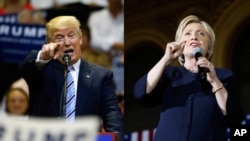As if the process to nominate Democratic and Republican candidates were not dramatic enough, the race to be the next president of the United States intensifies now that the parties have chosen Hillary Clinton and Donald Trump.
Both Clinton and Trump spent about a year focusing largely on voters who feel strongly enough about a party to register as a Democrat or a Republican. But more voters identify themselves as independents than side with either party, collectively leaving them as the biggest target for the November 8 election.
Raising and spending money
One vital task for both Clinton and Trump is convincing donors to contribute enough cash to pay for their campaigns.
“It’s important for funding the operations on the ground,” Democratic strategist Penny Lee told VOA. Campaigns need “paid staffers in these different states to be able to organize” even more than they need paid political advertising. “Free media in the presidential campaign is a lot easier than [in] a congressional race or others, but you need to get the enthusiasm of the base going out.”
The latest data from the Federal Election Commission showed Clinton’s campaign began July with $44 million in the bank compared to $20 million for Trump. Clinton had also outspent Trump $230 million to $71 million for the entire election cycle.
History suggests both candidates are just getting started in terms of spending. President Barack Obama's campaign committee spent $775 million of its own money to get him re-elected in 2012. His challenger, Republican Mitt Romney, spent $460 million. The Republican Party, Democratic Party and outside groups added several hundred million more dollars to the race as well.
Debates
The day-to-day campaigning will look a lot like it did during the primary process, with candidates holding rallies and other events in towns across the United States. There will be a special focus on so-called swing states that are considered to be the most competitive and carry the biggest weight on election day. Those include Florida, Ohio and Pennsylvania.
But the key difference between rallies in August and September and those last March is that they will not have the immediate payoff of having people vote right afterward, as happened during the primaries. Instead, a candidate’s message will have to stick in a voter’s mind until November before that person can cast a ballot.
The next defining event of the race will come September 26, when Clinton and Trump will participate in their first debate. They will debate a second time on October 9 and a final time on October 19. Trump’s running mate, Indiana Governor Mike Pence, and Clinton’s running mate, Virginia Senator Tim Kaine, will have a single debate, on October 4.
“People will get the chance to see just the two of them on stage without audience participation, to be able to go through and really dig down into the differences of the campaigns,” Lee said.
The 90-minute events will be televised nationally. Candidates will be told about the topics in advance but won’t know the exact questions. So they'll practice, often with someone role-playing as their competitor, to figure out the best lines of attack and to anticipate their opponent’s possible strategies.
“I think in the past, debates didn’t really matter because people who were already decided were the people watching it,” Republican strategist Lisa Spies told VOA. “I think this time it’s going to be amazingly different because it’s going to be entertainment.”
There is also the potential for third-party candidates to be involved and provide a different voice in the political process dominated by the Republicans and Democrats. But the debate rules require a candidate to appear on enough state ballots to have a mathematical chance of winning the election and to get at least 15 percent support in five national polls.
The leading third-party candidate, Libertarian nominee Gary Johnson, has been polling at between 5 and 10 percent.
Overcoming the negatives
After the debates, campaigns will make a final push to both convince voters that their candidate is the best choice and to make sure that people actually show up to vote. For the 2012 election, about 55 percent of eligible voters cast a ballot for president.
Election Day is not a national holiday in the United States, though schools in many places are closed because they serve as polling places. Voting takes place on a Tuesday for about 12 hours in each state. Results are announced not long after polls close, unless the race in a particular location is close.
The winner usually is known that night but will not be official until January 6.
That is because the United States uses a system called the Electoral College, which assigns a certain number of electors to each state based on its population. In all but two states, the candidate who gets the most votes gets all of the electors. Whichever candidate gets at least 270 of the 538 total electoral votes becomes the next president.
The system leaves open the possibility that the winner is not the one who gets the most overall votes nationally, as happened to Democrat Al Gore in 2000 when he won the popular vote but had fewer electors than George W. Bush.
For either Trump and Clinton to win, Lee highlighted the need for each to counter his/her negative perceptions among voters.
“I think for Donald it’s to begin to act and look presidential and not get into these 140 character battles on Twitter with individuals and stepping on his own message,” she said. “For Mrs. Clinton, I would say she’s got to continue to show a personal side, an empathetic side and a side that continues to prove that she is trustworthy.”
The winner will take office on January 20.
Elizabeth Cherneff contributed to this story.
















